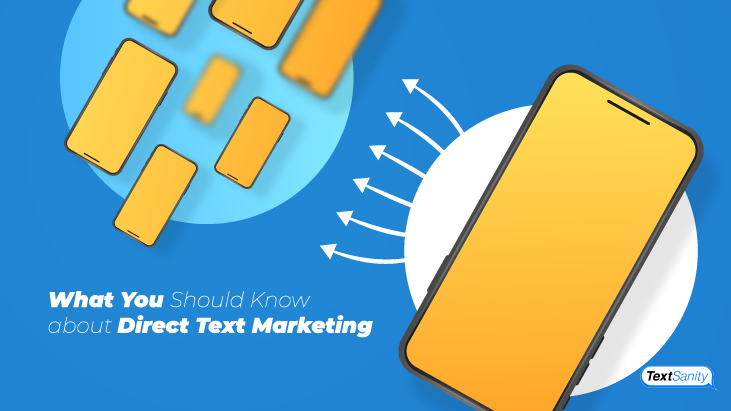What You Should Know about Direct Text Marketing
Even before the events of the last year, we were never far from our cell phones. In fact, two-thirds of Americans check their phones 160 times per day. We do everything on our cell phones.

Around the world, 70% of the earth’s population has a cell phone capable of receiving an SMS text message. In the United States, 46% of smartphone users admit to checking their phones before they get out of the bed in the morning. Needless to say, people are extremely reachable on their phones.
With the prevalence of cell phones, it didn’t take long for companies to realize reaching customers on their devices is not only achievable, but profitable. Additionally, companies didn’t expect customers to be so open to receiving marketing on their cell phones.
![]()
What is marketing?
As you may know, marketing is how a company promotes the selling of their products, goods, or services. Marketing existed long before it had a name. Even in ancient times, word-of-mouth marketing happened at the local well when people traded where they bought the best wool.
Now, with cell phones, humans connect with each other from around the world. Word-of-mouth marketing has a new look. Marketing is an entire industry and school of study where the process of promoting a business is strategized.
Inbound marketing
In all of this strategizing, a new methodology was discovered called inbound marketing. Inbound marketing is the process of a company helping potential customers find or discover their product or service. This process starts long before a customer is ready to make a purchase. The efforts focus on making a company stand out from competitors.
Inbound marketing utilizes various forms of pull-marketing to create or increase brand awareness. This creates brand preference long before a consumer is aware of and ready to acquire a product. Some forms of this pull-marketing are:
- Content marketing
-
Blogs
-
Social media
-
Search Engine Optimization
-
And more
The traditional method of outbound marketing seeks out customers, and relies on making cold contacts with potential customers that haven’t expressed an interest in a company or product.
Thus, inbound marketing focuses on a business’s efforts to increase visibility and draw customers in. So, essentially, potential buyers find you. This method builds brand awareness and develops relationships which generates leads for you.
Between society’s constant use of cell phones and this inbound marketing technique, it’s only natural that marketing merges these two treasures into a single experience for companies and customers.
Permission-based marketing
As part of relationship building, permission-based marketing was born. Permission-based marketing is just what it sounds like. Customers grant companies permission to use their contact information to be marketed to. In exchange, businesses add value by providing coupons, discounts, and exclusive offers.

The first tool of permission-based marketing is email marketing. Email marketing first started in 1978, and with it, the first spam message. Despite the moniker, even the first spam message was successful.
Since then, businesses learned the rules of permission-based marketing. Some things you should keep in mind are:
- Get consent first. Don’t message people who don’t give you permission. It’s a quick way to get your messages labeled as spam.
-
Be honest. Customers are open to direct marketing, but prefer to know what they’re signing up to receive.
-
Be clear. Written communication can easily be misinterpreted. State the information plainly.
-
Add value. Give people what they came for. Add value to their lives for the privilege of contacting them directly.
-
Don’t overdo it. Don’t send messages that are ubiquitous, repetitive, or unavoidable. Find a balance between getting the message out and adding value.

The rise of text message marketing
With the popularity of cell phones, people prefer text message marketing. Which is actually great news for businesses.

Since the first text message sent in 1992, texting has grown into one of the most prominent forms of communication. And popularity isn’t waning. Texts are instant. Instantly sent and received. Plus, they are incredibly convenient for both the sender and the receiver.
Text messages are sent and received all day every day around the world. They have an open rate of 97% within fifteen minutes of being sent. When a company sends a text marketing message to market themselves to a potential customer, that is direct text marketing.
Direct text marketing
Customers are receptive to direct text marketing and it’s a cost effective tool. Text message marketing can be implemented as a stand alone strategy or used in combination with other marketing tools.
If you are thinking of adding direct text marketing to your marketing strategy, here are some important things you need to know.
Customers need to opt-in to your direct text marketing campaign
The best way to build a database of subscribers is to have them text a keyword to a short code number from their cell phone.

Keywords are words or phrases text to a short or long code number. This keyword segments your customers into groups, so you send them relevant information. An example of this: customers who want to get a demo of your product text “DEMO” to 50505, your short code. While customers who want general information about your product text “CONTACT” to 50505.
After you develop a database, you can begin sending messages. It’s a good practice to use a drip campaign. This automates the process by sending pre-written texts at appropriately timed intervals to nurture prospects through your marketing funnel. Of course, the ultimate goal is a final purchase.
As with email blasts, mass texts are easier to send with a mass texting service. These businesses help send messages, gather analytics, and schedule direct text marketing messages.
![]()
Direct text marketing tips
In order to see the results you want, here are some important things to remember:

- Always announce yourself. People want to know who is texting them.
-
Keep it short. SMS messages need to stay under 160 characters to avoid being broken up and delivered as multiple messages.
-
USE CAPS LOCK. When you have a small amount of text to work with, you can really benefit from the eye grabbing effect of using caps lock.
-
Use URL shorteners. Your limited character space in an SMS message means you do not have room for lengthy URLs. For this reason, use the text marketing business of your choice’s URL shortener.
-
Test your text. Before you hit send on a text to an entire database of subscribers, send it to yourself first. View your text on different devices. Check it for readability, spelling and grammar.
Follow these guidelines to help develop messages that get opened, read, and clicked through. The effectiveness of your campaign is evident through the data points you collect. Adjust your efforts based on the information you collect.
Summary
With the common everyday use of cell phones, it makes sense that businesses have found a way to reach consumers directly on their mobile devices. Large and small businesses alike benefit from reaching potential customers and cultivating relationships using direct text marketing.
In conjunction with other marketing techniques, direct text marketing creates brand awareness and nurtures leads. Add value and keep your customer’s attention.
Take advantage of customers reaching for their phones 160 times every day. Be the text message your subscribers are reading, clicking on, and following.


